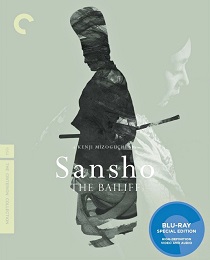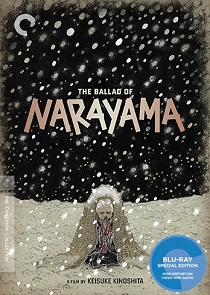Two Japanese folk tales come to life with starkly different approaches in the latest Blu-ray restorations from The Criterion Collection. Each of them is powerful in their own unique way and give a glimpse of traditional Japanese storytelling through the eyes of the mid-20th century.
Shot entirely on indoor soundstages (except for the very last shot), director Keisuke Kinoshita‘s The Ballad of Narayama is nonetheless a beautiful-looking movie. In fact, you might say that the blatantly artificial and expressive set design is the real star of the film.
The entire film is told using the kabuki tradition, which is why curtains open the film. Once the joruri narrator enters the frame and begins to speak, the curtains open to reveal the setting of a remote mountain village, rendered in deep, stylized colors. Another transition later in the film has tree branches parting like curtains. It’s just one of many experimental visual moments that contrasts Kinoshita’s rather straightforward narrative, which concerns the legend of Obasute — the abandonment of old people.
Orin (Kinuyo Tanaka) is the elderly woman at the center of the tale, and she is already looking ahead to the day when she can travel to Narayama, at the top of the mountain, and no longer be a burden to her family. Before that happens, however, she must secure a wife for her recently widowed son. Her relationship with her son Tatsuhei (Teiji Takahashi) is the driving emotional core of the story. Their closeness is in stark contrast to Orin’s grandchildren, who are selfish and rude, demonstrating the foolishness of youth and an inability to grasp the severity of the situation.
The joruri comments on the action in the story, giving us the character’s thoughts and his own philosophical musings. Sometimes the narration comes in the form of songs, accompanied by a stringed instrument called a samisen. Even though the gorgeous sets, widescreen composition, and fluid camera movement are striking, The Ballad of Narayama has a very slow, contemplative feel. Modern audiences may find it difficult to adjust to its laconic pace, but it is a stirring tale, full of dignity and sorrow, and worth checking out for sure.
Sansho the Bailiff (1954)
 Kenji Mizoguchi‘s cinematography in Sansho the Bailiff is impressive as well, but it comes from a completely different strategy. Mizoguchi shot outside on location and rendered his shots of the unforgiving Japanese countryside in stark black and white. Working from a novel by Ogai Mori (which is itself based on an old folktale), Sansho the Bailiff tells the story of a family in the 11th century that is torn apart when their father, a local governor, is thrown into exile for shielding his peasants from a wartime draft.
Kenji Mizoguchi‘s cinematography in Sansho the Bailiff is impressive as well, but it comes from a completely different strategy. Mizoguchi shot outside on location and rendered his shots of the unforgiving Japanese countryside in stark black and white. Working from a novel by Ogai Mori (which is itself based on an old folktale), Sansho the Bailiff tells the story of a family in the 11th century that is torn apart when their father, a local governor, is thrown into exile for shielding his peasants from a wartime draft.
This tale is also a deeply affecting drama, but it takes on an epic scope when it follows the adventures of both children as they are sold into slavery under the bailiff of the title, and follows their story over many years to its mournful conclusion. Like The Ballad of Narayama, Sansho the Bailiff also unfolds at a slow pace, featuring lots of long takes, and a plaintive traditional score also accompanies the film, this one mostly played on the flute and harp.
Mizoguchi elevates the family’s personal struggle to make comments on Japanese culture in general. Before the father leaves, he tells his son Zushio (Yoshiaki Hanayagi) an important lesson he will soon forget: “Without mercy, man is like a beast … even if you are hard on yourself, be merciful to others.” and “Men are created equal, everyone is entitled to happiness.” It is difficult for Zushio and his sister to keep this as focus through all their years of torturous struggle.
Like The Ballad of Narayama, Sansho the Bailiff is a tragic story, one which illuminates the human condition and gives you plenty of time to think. It is the nature of nature to show no mercy, but mercy is inherent to the nature of human beings, even when it seems buried under loads of suffering.
The Blu-ray features audio commentary featuring Japanese-literature scholar Jeffrey Angles, plus interviews with critic Tadao Sato, assistant director Tokuzo Tanaka, and actress Kyoko Kagawa on the making of the film and its lasting importance.









Comments on this entry are closed.